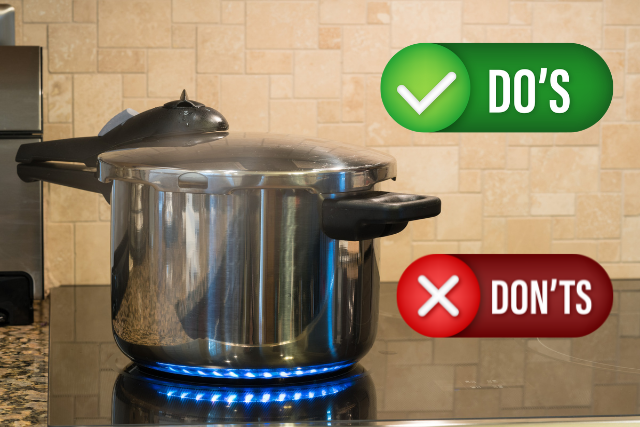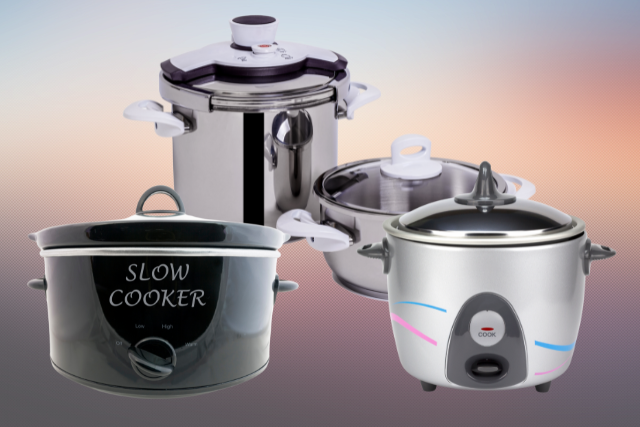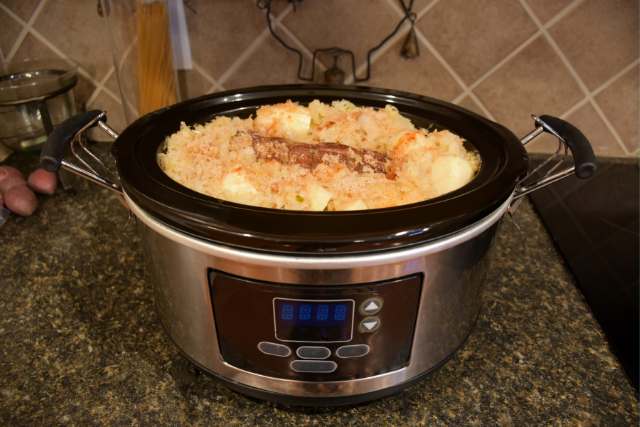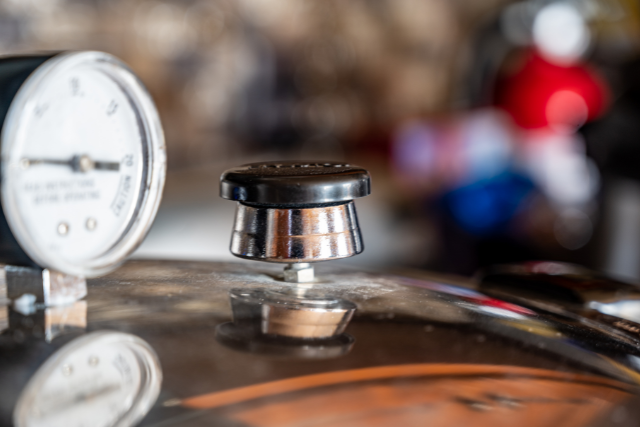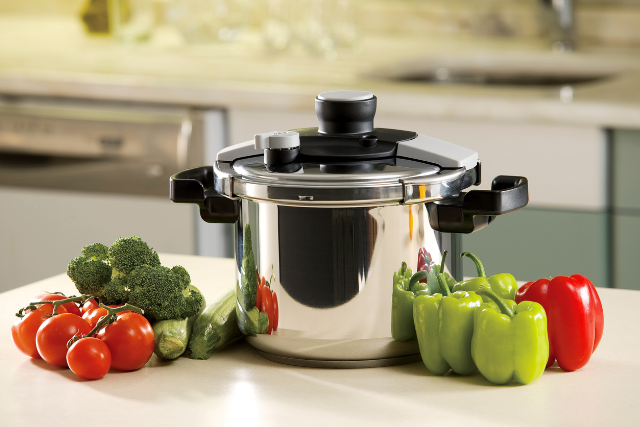How to deal with the bulging bottom of the pressure cooker?

A pressure cooker is a kitchen appliance that cooks food faster than a regular pot by using steam pressure. The steam pressure builds up inside the pot, and this allows the food to cook quickly. However, if the pressure gets too high, the pot can “bulge.” This can happen if the pressure cooker is not set correctly, or if it is not vented properly. If this happens, it is important to release the pressure before opening the pot. Otherwise, the food inside can be overcooked or burned.
Why the bulging bottom of the pressure cooker is a problem?
A pressure cooker is a kitchen appliance that uses steam pressure to cook food. The steam pressure is created by boiling water in the bottom of the pot. This produces a lot of heat, which cooks the food very quickly. The problem with this design is that the bottom of the pot can become very hot, causing the pot to bulge outwards. This can be dangerous because it can cause the pot to explode, injuring anyone nearby.
How to prevent the bulging bottom of the pressure cooker?
Following are the tips to prevent the bulging bottom of the pressure cooker.
Make sure that the pot is not overfilled.
One way to prevent the bulging bottom of the pressure cooker is to make sure that the pot is not overloaded. This can be done by ensuring that the ingredients do not exceed the maximum fill line. Another way to prevent the bulging bottom is to make sure that there is enough liquid in the pot. The minimum amount of liquid required is typically two cups.
Use a pressure regulator when cooking
A pressure regulator helps to regulate the amount of pressure that builds up in the pot, which can help to prevent bulging. Using a pressure regulator is not the only way to prevent bulging, but it can be an effective measure to take. If you’re not sure how to use a pressure regulator, be sure to consult your pressure cooker’s manual or an expert before using one.
Make sure that the pressure cooker is set on a level surface while it’s cooking
When using a pressure cooker, be sure to set it on a level surface. This will help distribute the heat evenly and prevent the bottom of the cooker from bulging. If the bottom of the cooker begins to bulge, it can cause the lid to come off, which can be dangerous.
How to deal with the bulging bottom of the pressure cooker?
If your pressure cooker has a bulging bottom, there are a few things you can do to fix the problem. If neither of these solutions works, then you may need to buy a new pressure cooker.
Don’t panic
When it comes to the bulging bottom of a pressure cooker, don’t panic. This is a relatively common occurrence that can be easily fixed. The most likely cause is that the pressure release valve is blocked. To fix this, simply open the valve to release the pressure and then clean it with a brush or toothpick. If the problem persists, you may need to replace the valve. Another possible cause is that the gasket, or ring, around the edge of the lid, is not sealing properly. Inspect the gasket for any cracks or damage and replace it if necessary. With a little troubleshooting, you can get your pressure cooker back up and running in no time.
Check the manual
If your pressure cooker has a bulging bottom, there are a few things you can do to try to fix the problem. First, check the manual that came with your pressure cooker. There may be some specific instructions on how to deal with this issue. If not, you can try a few different things.
One option is to try and straighten out the bottom of the pressure cooker. This may be difficult, and you may need to use some tools to help you. Another option is to place the pressure cooker on a heat-resistant surface and use a hammer to gently tap around the outside of the bulge. This may help it to return to its original shape.
If neither of these options works or if your pressure cooker is too badly damaged, you will need to replace it.
Check for leaks
If your pressure cooker is starting to bulge at the bottom, it’s important to check for leaks. Leaks can cause the pressure cooker to lose pressure, which can be dangerous.
To check for leaks, start by making sure that the gasket and vent tube is clean and free of any debris. Next, fill the pressure cooker with water and put it on the stove. Turn up the heat to high and wait for the water to come to a boil. Once the water starts boiling, turn off the heat and let the pressure cooker cool down.
Once it’s cooled down, open the pressure cooker and check inside for any water leaks. If you see any water leaks, you’ll need to replace the gasket or vent tube.
Lower the heat
If your pressure cooker starts to bulge at the bottom, it’s time to lower the heat. This is a common issue with pressure cookers and one that is easily fixed. Simply turn the heat down to low and allow the pressure cooker to release its pressure slowly. Once the pressure has been released, you can safely remove the lid and continue cooking.
Release the pressure
If you’ve ever cooked with a pressure cooker, you know that they can be tricky devices. The key to using a pressure cooker is to release the pressure gradually. If you release the pressure too quickly, the food inside can be overcooked or even explode.
There are two ways to release the pressure from a pressure cooker: natural release and quick release. Natural release is when you simply turn off the heat and allow the pressure cooker to cool down on its own. This method is used for delicate foods like fish or vegetables that could be overcooked if exposed to a sudden change in temperature.
Quick release is when you use the valve on the top of the pressure cooker to let out steam and lower the internal pressure quickly. This method is used for meats and other tough foods that can withstand a sudden change in temperature.
Let it cool
If you’re dealing with the bulging bottom of a pressure cooker, the first thing you should do is let it cool. Pressure cookers can build up a lot of pressure, so it’s important to let the cooker cool down before attempting to fix the problem. Once the cooker has cooled, check to see if the pressure release valve is working properly. If not, you may need to replace the valve. If the pressure release valve is working properly, then your pressure cooker should be fine and you can continue using it.
Seek the opinion of an expert
When it comes to finding a solution for the bulging bottom of the pressure cooker, it is best to seek the opinion of an expert. This is because they will be able to assess the situation and provide a tailored solution. However, there are some things that you can do in order to try and fix the problem yourself.
One thing that you can do is to make sure that the pressure cooker is level when you are cooking with it. This will help to distribute the pressure evenly and prevent the bottom from bulging out. Another thing that you can do is to reduce the amount of liquid that you are using in your recipes. This will also help to reduce the amount of pressure that is built up in the cooker.
If you find that these solutions do not work, then it is best to consult with an expert.
Conclusion
If the bottom of your pressure cooker is bulging, don’t panic. The most important thing is to release the pressure before opening the cooker. Once the pressure is released, you can remove the lid and check for damage. If there is any damage, it’s best to discard the cooker and buy a new one.

